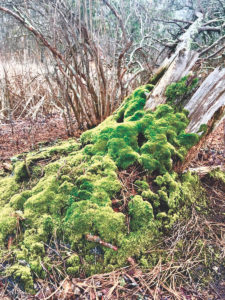The woods are a thousand tans, reds, and browns. Furrowed bark every shade of charcoal. Snowfall in the woods, in the low winter light, a cast of blue. The muted greens of sleeping pines and inkberry are the only signs that photosynthesis is happening here. The landscape is a study in subtle, quiet color.

Most days, everything is wet. The temperature does not rise enough in winter to dry anything out. Now and then, everything freezes deeply. The air feels clear and crisp. The dryness pinches at your skin and the already quiet colors of the woods fall nearly silent. The ocean turns a shade of cold steel.
Then it warms again. A sunny winter day of soft air and wind that doesn’t sting. Everything relaxes and swells. The deep, soaking wet of melting snow seeps slowly into a receptive earth. Long, slow drizzles and decaying wood, everything is soggy. From the crumbling edges of dirt roads, following the form of rotting logs, creeping between roots, something bright catches you off guard: moss, vibrant green in a palette of earth tones. It looks like the artist spilled her paint on the winter landscape and decided not to wipe it off, because it worked, because it was hopeful, because it made her smile.
There are approximately 12,000 species of mosses. They are classified as Bryophyta under the kingdom of Plantae. They are unique in that they lack a proper vascular system; they have no xylem to conduct or store water within their tissues. All of the nutrients and water that mosses gather are taken in through their leaves, which are generally only a single cell thick. What we imagine to be their root system, the threadlike rhizoids, only anchors the mosses to whatever surface or substrate they are growing on. Like fungi and ferns, they reproduce using spores, not seeds. They are some of the few plants that will never flower.
There are two types of mosses. There are the little tufted ones that look like grassy hillocks, their tissue growing upright into green mounds. These are the acrocarpous mosses. They grow slowly and require dry spells between soaking to survive. If they become too soggy, they degrade and rot away. The others are the low spreading mosses. The mosses that lie flat and creep outward with chaotic, branching fingers. These are the pleurocarpous mosses. They love the water and thrive in soggy places. They are fast growing and tend toward shadier spots.
The success of moss is due to its adaptability. You will find them growing in the iron-rich orange sand of washed-out hillsides or clinging to the bark of oak trees. They may line the unclean, silted creases of your gutters or trace the lines of the windshield gasket of an old car parked in the shade. They are opportunistic. Because they lack a vascular system, they respond only when the environment gives them what they need to get their little green engine turning. They waste no energy. I suppose they are quite Zen in this sense; they sleep when they are tired and drink when they are thirsty. I love to see them peeking out through a break in the snow, sucking up the melt water and shining through in almost unsettling brilliance.
A good place to see moss at its finest is in the white cedar swamp in Wellfleet. The swamp is a low boggy forest of spiraling cedar bark, gnarled tree forms, and moss. I go to see the green, that bright expression of life.
There is a mystical, magic quality to moss. The endless blanket and rolling islands of it create a scene from a fairytale. When I see all the moss, wrapping itself in a slow dance around the roots and trunks of the cedars, I find myself smiling, half expecting a gnome to pop his head out of a hollowed knot, or a fairy to go drifting past. And it almost wouldn’t even be weird.



